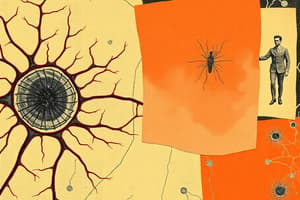Podcast
Questions and Answers
Cell adhesion processes occur only between cells and the extracellular matrix (ECM)
Cell adhesion processes occur only between cells and the extracellular matrix (ECM)
False (B)
The ECM provides mechanical support for cells and tissues
The ECM provides mechanical support for cells and tissues
True (A)
Cadherins and selectins are examples of cell adhesion receptors
Cadherins and selectins are examples of cell adhesion receptors
True (A)
Integrins and syndecan molecules are involved in cell-matrix adhesion
Integrins and syndecan molecules are involved in cell-matrix adhesion
Extracellular Matrix (ECM) does not influence cell shape or cell movement
Extracellular Matrix (ECM) does not influence cell shape or cell movement
Cell adhesion processes involve the formation of physical bonds between adjacent cells through cadherins, selectins, and the members of the IgCAM family.
Cell adhesion processes involve the formation of physical bonds between adjacent cells through cadherins, selectins, and the members of the IgCAM family.
Cell-matrix adhesion involves the formation of physical bonds between cells and adhesive proteins in the extracellular matrix (ECM) through integrins and syndecan molecules.
Cell-matrix adhesion involves the formation of physical bonds between cells and adhesive proteins in the extracellular matrix (ECM) through integrins and syndecan molecules.
The extracellular matrix (ECM) provides mechanical support for cells and tissues, integrates cells into tissues, and influences cell shape and cell movement.
The extracellular matrix (ECM) provides mechanical support for cells and tissues, integrates cells into tissues, and influences cell shape and cell movement.
The majority of adhesion molecules fall into one of four families: Cadherins, Integrins, Fibronectins, and Ligands.
The majority of adhesion molecules fall into one of four families: Cadherins, Integrins, Fibronectins, and Ligands.
The extracellular matrix (ECM) serves as a reservoir for intracellular signaling molecules only.
The extracellular matrix (ECM) serves as a reservoir for intracellular signaling molecules only.
Which family of molecules is involved in cell-matrix adhesion?
Which family of molecules is involved in cell-matrix adhesion?
What is the function of the extracellular matrix (ECM) in multicellular organisms?
What is the function of the extracellular matrix (ECM) in multicellular organisms?
Which molecules form physical bonds between adjacent cells in cell-cell adhesion?
Which molecules form physical bonds between adjacent cells in cell-cell adhesion?
What is the main function of adhesion proteins in cell biology?
What is the main function of adhesion proteins in cell biology?
Which molecules are examples of cell adhesion receptors?
Which molecules are examples of cell adhesion receptors?
Flashcards
Cadherins and Selectins
Cadherins and Selectins
Proteins that mediate cell-cell adhesion.
Integrins and Syndecans
Integrins and Syndecans
Proteins that mediate cell-matrix adhesion.
Extracellular Matrix (ECM)
Extracellular Matrix (ECM)
Provides mechanical support, tissue integration, and influences cell shape/movement.
Cell-Cell Adhesion
Cell-Cell Adhesion
Physical bonds formed via cadherins, selectins, and IgCAM family members.
Signup and view all the flashcards
Cell-Matrix Adhesion
Cell-Matrix Adhesion
Physical bonds formed via integrins and syndecan molecules.
Signup and view all the flashcards
Adhesion Proteins Function
Adhesion Proteins Function
Coordinates cellular functions through signaling with cellular adhesion receptors.
Signup and view all the flashcards
Cell-matrix adhesion molecules
Cell-matrix adhesion molecules
Integrins and syndecan molecules
Signup and view all the flashcards
Cell-cell adhesion molecules
Cell-cell adhesion molecules
Cadherins, selectins, and IgCAM family members
Signup and view all the flashcardsStudy Notes
Cell Adhesion Processes
- Cell adhesion occurs between cells and the extracellular matrix (ECM), facilitating communication and interaction.
- Cadherins and selectins are key cell adhesion receptors that mediate binding between adjacent cells.
- Integrins and syndecan are critical for cell-matrix adhesion, linking cells to the ECM.
Extracellular Matrix (ECM) Role
- The ECM provides mechanical support to cells and tissues, acting as a structural scaffold.
- It integrates cells into tissues, influencing their organization and function.
- ECM affects cell shape and movement, contrary to certain claims that it does not.
Families of Adhesion Molecules
- Four primary families of adhesion molecules exist: Cadherins, Integrins, Fibronectins, and Ligands.
- These proteins facilitate both cell-cell and cell-matrix interactions, essential for tissue integrity.
Cell-Matrix Adhesion
- Physical bonds in cell-matrix adhesion form through interaction of cells with adhesive proteins present in the ECM, primarily via integrins and syndecan.
- Adhesion proteins play a vital role in communication, signaling, and maintaining tissue organization.
Function of Adhesion Proteins
- Adhesion proteins are responsible for establishing physical connections between cells and the ECM, crucial for tissue stability and cellular function.
Studying That Suits You
Use AI to generate personalized quizzes and flashcards to suit your learning preferences.



